Have you previously heard of the 5/25 Rule? It’s an effective productivity method if you follow it. It’s a rule that lists your 25 goals and only focuses on your top 5.
You can filter most of the distractions if you apply it. Let me break it down for you.
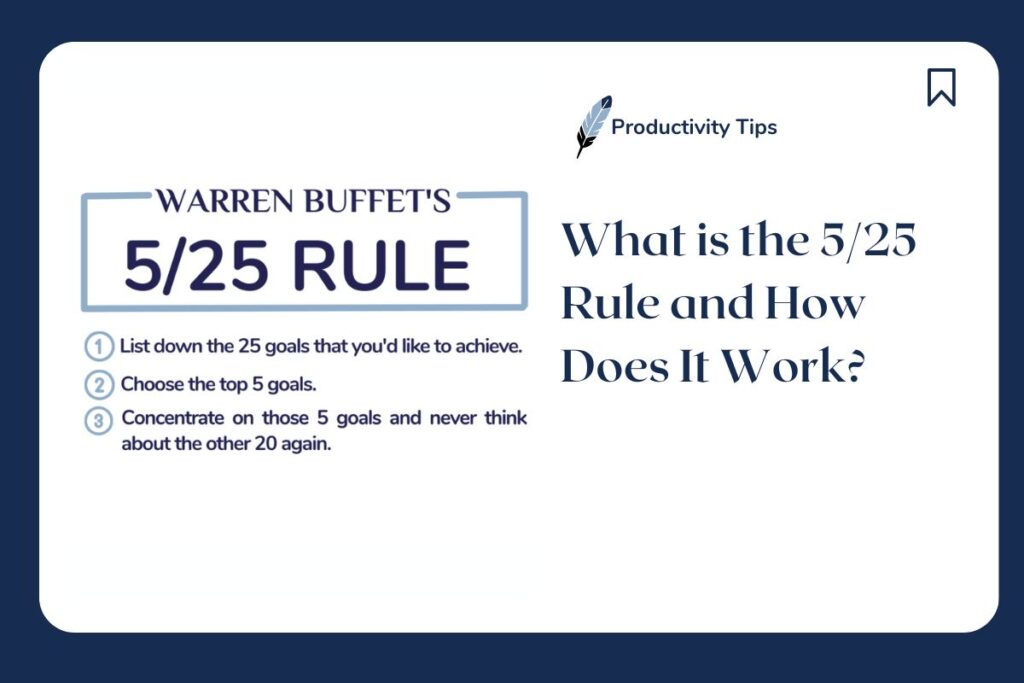
Table of Contents
What is the 5/25 Rule and How Does It Work?
When I first read about it, I was immediately struck by its simplicity and effectiveness. I agree that it is similar to Ivy Lee’s Method.
But it is pretty different. Both are effective.
Yet each productivity method provides a different application.
I explained the 5/25 approach below, which I learned from a blog [1].
- The first step is to compile a list of your top 25 objectives. These can be long-term or short-term goals, or they can be aspirations for the future.
- Second, rank your list by selecting the top five priorities. These are the ones that share your ideals and goals for the future.
- Next, ignore or scrap the other 20 projects and concentrate on the top 5. This way, you focus on what matters most instead of trying to do everything at once.
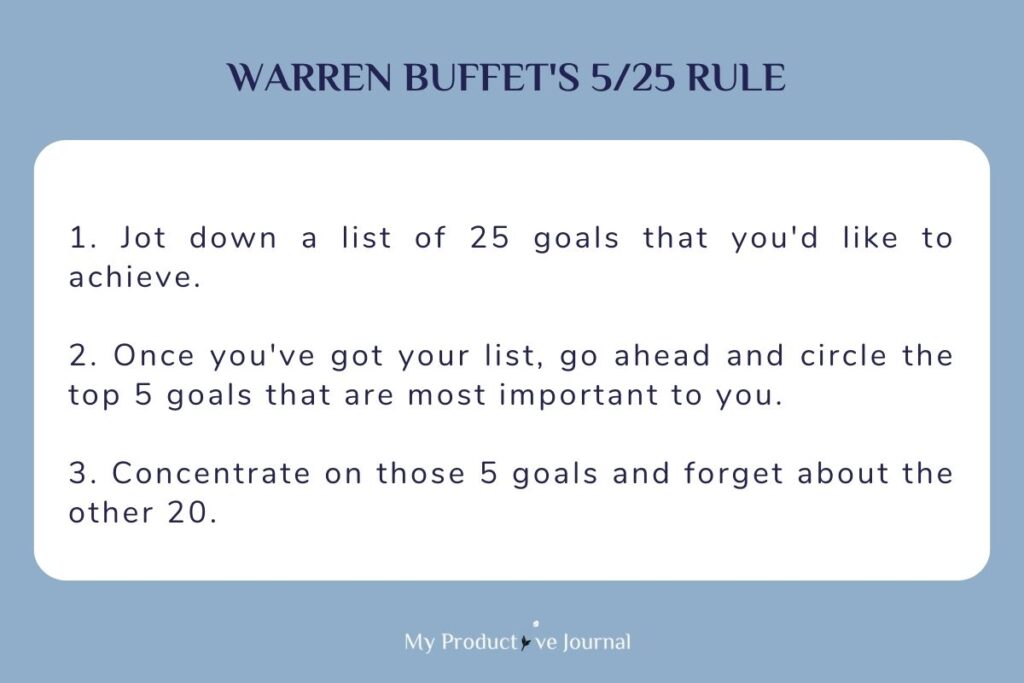
Pros and Cons of the 5/25 Rule
Let’s weigh the benefits and drawbacks of the 5/25 Rule.
The 5/25 Rule’s Pros
- Concentration and priorities
The rule aids in identifying and concentrating on the most vital priorities.
By selecting only the top five items on your list, you can avoid feeling overwhelmed and concentrate instead on what matters.
- Effectiveness and efficiency
The 5/25 Rule is ideal because it helps you be more effective and efficient. It lets you concentrate on your most important tasks.
You give yourself the room and resources needed to make real progress. This intentional and strategic approach helps you avoid feeling overwhelmed.
- Coherence and precision
The 5/25 rule helps you focus on the big picture and stay on track. It compels you to pick the most aligned with your future ambitions.
This awareness will serve you well as you continue working toward your values.
Cons of the 5/25 rule
- Potentially ignored opportunities
There is a danger of missing out on great possibilities if you limit yourself to only five tasks.
Finding the right balance is significant, as is keeping an eye out for new opportunities for progress that may arise apart from your intended goals.
- Limited perspective
The rule could restrict your ability to try new things and see what else exists.
While setting priorities is vital, so is keeping an open mind and being flexible enough to adjust your plans.
📌 The 5/25 rule is a guideline; it may not always be applicable. Testing its usefulness in light of your situation, objectives, and personal preferences is crucial.
What Makes the 5/25 Rule So Effective?
Warren Buffett’s 5/25 rule is an effective tool for reaching your daily tasks. But how come it works so well?
Let’s dig in and start reaping the rewards right away!
- You won’t have to split your attention.
Envision yourself with an overwhelming list of things to do. Where do you even begin?
The 5/25 rule has come to save the day!
Choosing the top five projects requires you to settle on what matters most.
It prevents you from spreading yourself too thin and allows you to focus on what’s relevant today.
- You will make the most of your efforts and time.
Have you ever felt that your to-do list was never going to end? All of us may relate to that feeling.
However, with the 5/25 rule, you won’t have to worry about that anymore.
Focusing on one or two things at a time will help you avoid becoming overwhelmed.
And when you do finish them, you’ll feel a tremendous sense of accomplishment and drive.
- The way forward toward your tasks is undeniable.
Imagine you routinely evaluate your top five priorities.
To what end does that serve?
Definition and purpose!
The 5/25 rule guarantees you’ll work for the right things over time. It serves as a guidepost toward your goals.
The 5/25 rule is simple to use, so go ahead and give it a shot.
Tips to Get The 5/25 Focus
Think of a resource that helps you accomplish what’s important to you.
Well, using the 5/25 rule, here are my tips for you.
- Clear your mind
Before you start writing your list, take a moment to clear your mind. Consider it like decluttering your room.
You can take deep breaths or write in a journal.
- Prioritize ruthlessly
When deciding on the most important tasks, be ruthless in prioritizing.
Think about how each task will impact your goals and growth. Focus on tasks that align with your long-term dreams and values. Eliminate tasks that aren’t essential or are appropriate for someone else to handle.
- Break down goals into actionable steps
Sometimes big goals can feel overwhelming, like eating a large piece of meat.
But breaking them down into smaller chunks will make it easier to bite.
This way, you can celebrate small successes and keep moving forward.
- Create a clear plan
Now that you have your top 5 tasks, create a clear plan for each one. Think of it as creating a map to success.
Break each task into smaller milestones and set deadlines for yourself. Staying on track and seeing how far you’ve come becomes easier when you have a plan!
Creating a vision board with your old planner is one way to ensure your plans are clear.
- Defeat distractions
Distractions can hijack your attention and derail all of your hard work. To defeat them, minimize distractions as much as possible.
Put away your phone notifications and find a quiet space to concentrate.
You can even try techniques like the Pomodoro Technique, where you work in 25-minute spurts followed by 5-minute breaks.
- Practice discipline
To be truly productive, stick to the 5/25 rule! It’s tempting to work on other tasks but remind yourself of the benefits of this rule.
You’ll make incredible progress and achieve your goals faster by giving full attention to the most important tasks!
- Review and adjust
Regularly review your top 5 tasks and make adjustments if needed. Sometimes your priorities change as you adapt to new challenges.
Be flexible and ready to handle what’s unexpected.
Implementing the 5/25 rule requires commitment and discipline. Be patient, and keep practicing until it becomes second nature.
Example of the 5/25 Rule
To illustrate what I am trying to say, here’s a great scenario that will help you understand what the 5/25 rule is all about.
How Matthew achieved his goals with the 5/25 rule:
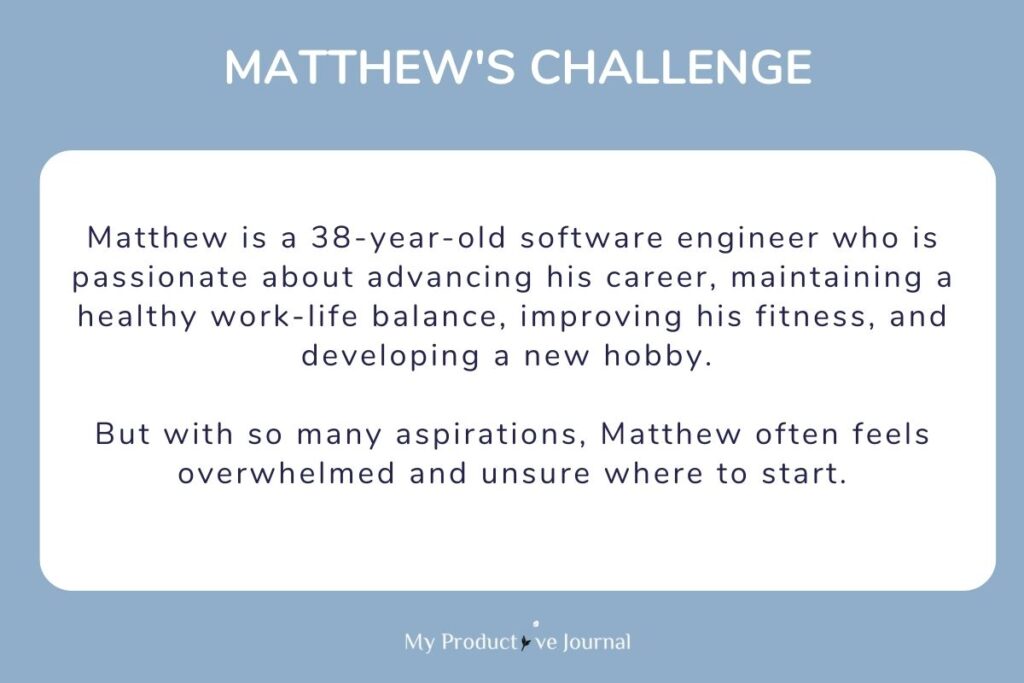
Step 1: Identifying his 25 rule
Matthew decided to go on with his strategic planning to reach his goal. He sat down with a pen, feeling determined.
He started listing 25 objectives covering all his ambitions.
Each objective was a stepping stone. It was guiding him closer and closer to his ultimate destination of success.
- Complete a coding certification.
- Lead a team project at work.
- Improve time management skills.
- Run a marathon.
- Learn to play the guitar.
- Travel to a new country.
- Meditate daily.
- Obtain a promotion.
- Enhance public speaking skills.
- Develop a new software application.
- Read 25 books in a year.
- Take a photography course.
- Learn a new programming language.
- Volunteer for a local charity.
- Start a meditation practice.
- Attend industry conferences.
- Improve financial literacy.
- Take a cooking class.
- Spend more time with family.
- Explore a new hobby like painting or gardening.
- Complete a home renovation project.
- Expand professional network.
- Learn to manage stress effectively.
- Start a blog to share expertise.
- Improve physical fitness through regular exercise.
Step 2: Choosing his top 5 rule
Matthew narrowed his focus after carefully laying down his 25 goals. He considered each goal’s importance and how it may affect his journey.
Matthew applied the 5/25 rules to choose his top 5 goals. He realized that focusing on a few things was the only way to grow.
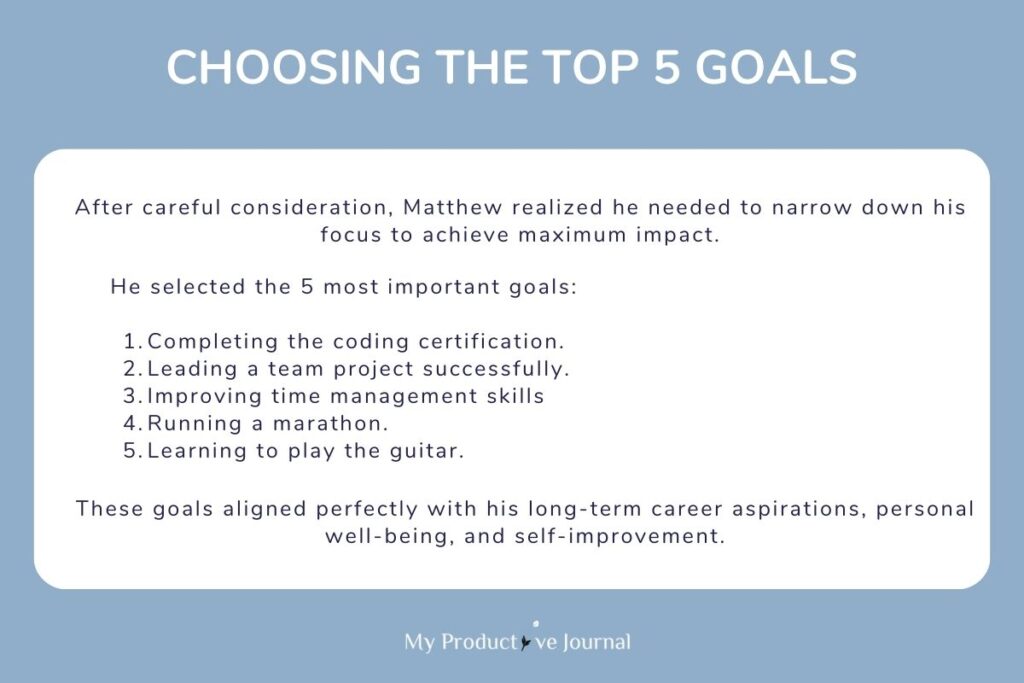
Step 3: He prioritizes success
Matthew was determined and focused as he embraced his top 5 priorities. He saw them as the foundation that would lead to his success.
They were like his compass.
He put a lot of time, effort, and attention into these specific things. Every step he took got him closer to his goals.
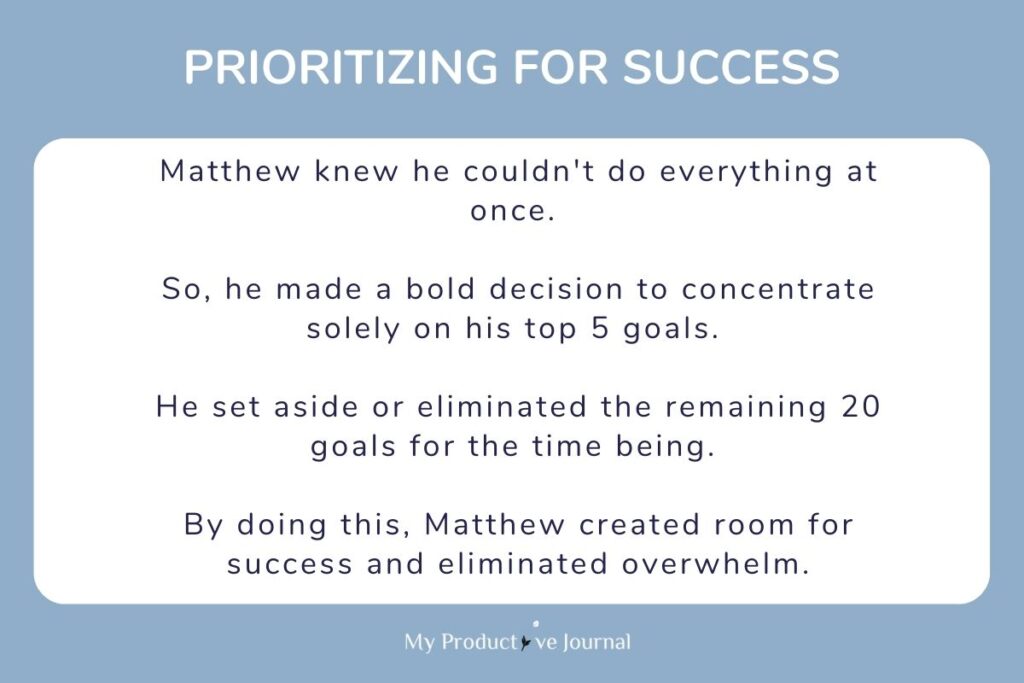
Step 4: His results
The 5/25 rule gave Matthew direction and purpose. The act of establishing his top 5 priorities helped him optimize his efforts and eliminate distractions.
He prioritizes his time, resources, and energy to maximize his success.
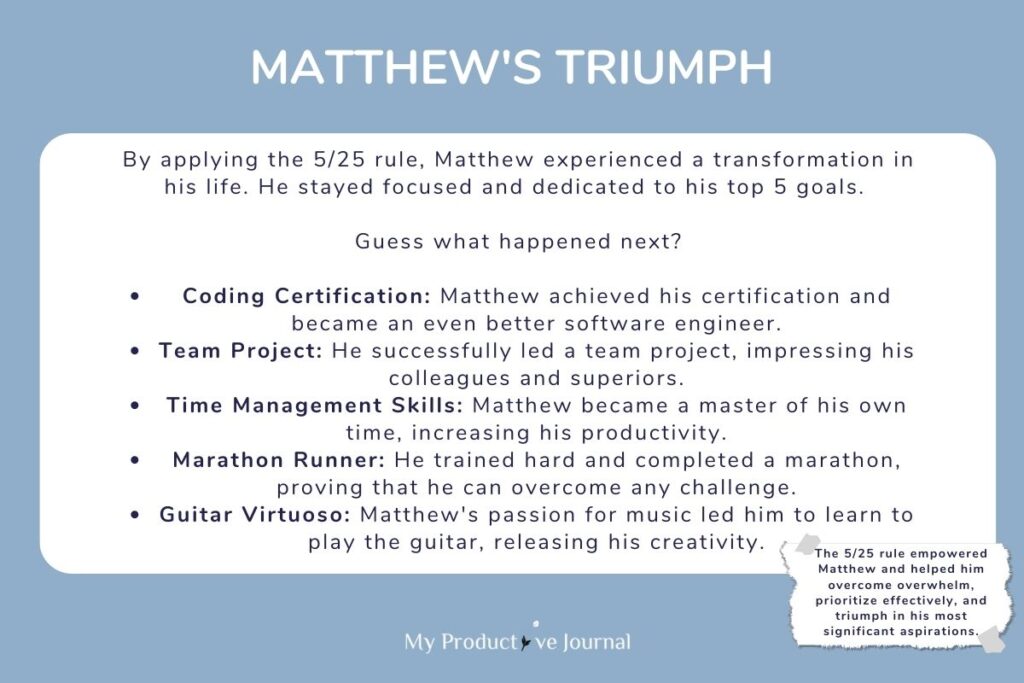
You can make a list of 25 goals or tasks, just like Matthew.
Think about:
What matters to you?
What helps you reach your long-term goals and keep you healthy?
Once you know your top 5 goals, commit yourself to improving.
Whether coding, leading a team, getting better at something, running, or following a hobby, the trick is deciding what’s most important to you. Use the 5/25 rule to help you reach your goals, just like Matthew did.
Now, you must venture out and make those goals come true.
5/25 Rule (FAQs)
What is the 25/5 rule of emotional intelligence?
The 25/5 rule has nothing to do with emotional intelligence. It is a productivity approach in which you list 25 goals or chores and then prioritize and focus on the top 5 to avoid feeling overwhelmed and to make progress toward what is genuinely important.
Who is Warren Buffet?
Warren Buffet is a famous investor. He popularized the 5/25 rule, a productivity method in which you list 25 goals or tasks. And then prioritize and focus on the top 5 to overcome everyday stress, achieve important goals, and feel good about it.
What to do next?
If you consistently focus on your long-term goals, the day-to-day concerns and side goals fade into the background.
Applying this rule to your life will result in extraordinary accomplishments, and amazing transformations will follow.
You can navigate the vast ocean of personal growth and reach the highest point of success—if you keep trying and do not give up.
Hey! If you found this post useful, check out these productivity tips and tools too:
